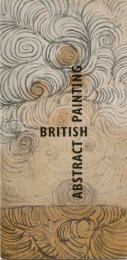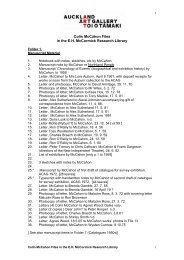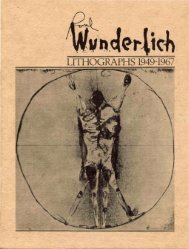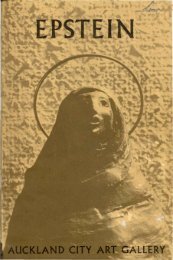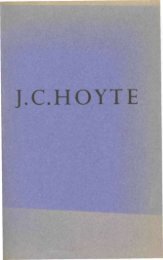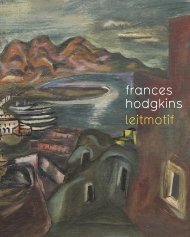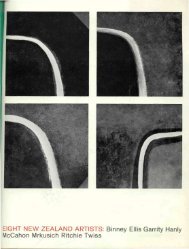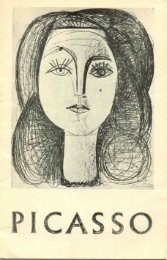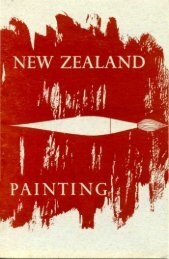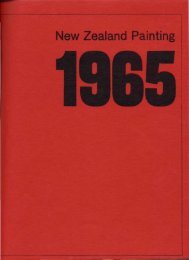Tissot - Still on Top (PDF, 4561.04KB) - Auckland Art Gallery
Tissot - Still on Top (PDF, 4561.04KB) - Auckland Art Gallery
Tissot - Still on Top (PDF, 4561.04KB) - Auckland Art Gallery
Create successful ePaper yourself
Turn your PDF publications into a flip-book with our unique Google optimized e-Paper software.
Unlike his Impressi<strong>on</strong>iSt compatriots many of <str<strong>on</strong>g>Tissot</str<strong>on</strong>g>'s representati<strong>on</strong>s of women<br />
c<strong>on</strong>tain a psychological undercurrent. Displayed as objeCls for the speClator's pleasure,<br />
wil:hin the image il:self there is often a sense of tensi<strong>on</strong> between the figures; women<br />
Studiously look away from their compani<strong>on</strong>s, and there is a slightly awkward sense that<br />
we are interrupting something. In Dunedin Public <strong>Art</strong> <strong>Gallery</strong>'s W011ing for the Train<br />
(Willesden JunCti<strong>on</strong>) c1872 [see fig. I] a young woman Stands <strong>on</strong> the platform clutching<br />
various il:ems - parasol, book, flowers, bag, travelling b lanket - that mark her as<br />
modern, juSl: as the railroad il:self was seen as a symbol of c<strong>on</strong>temporary civilizati<strong>on</strong>.<br />
She gazes back at the speClator, but her very mode of travel suggeSl:s that the glance is<br />
fleeting - as if she is part of a narrative enaCled bey<strong>on</strong>d our view. By c<strong>on</strong>traSt, the<br />
woman in bed in WhiStler's etching [see fig. 2J is shown absorbed in her reading. She<br />
squints at her newspaper; the mood is intensely private. The curtains of her bed cut off<br />
our view, her <strong>on</strong>e caSl:-off slipper serving as a further barrier to the speClator. In<br />
c<strong>on</strong>traSt to War1ingfor the Train there is no suggeSti<strong>on</strong> that this is a momentary glimpse<br />
from a l<strong>on</strong>ger narrative.<br />
From the beginning of his Sl:ay in L<strong>on</strong>d<strong>on</strong>, <str<strong>on</strong>g>Tissot</str<strong>on</strong>g>'s Anglo-French Sl:yle was greeted<br />
WI1h a mixed resp<strong>on</strong>se, some English cril:ics sensing a satirical and sarcaStic element to<br />
his works. The IlluStrated L<strong>on</strong>d<strong>on</strong> News was not al<strong>on</strong>e in talking about 'French satire' and<br />
the 'Gallic sneer' , nor the Times about 'cynical sinceril:y' when they described his<br />
painting as 'French rather than English, alike in the ideas il: suggeSl:s and the skill il: shows'.<br />
In 187 4 <str<strong>on</strong>g>Tissot</str<strong>on</strong>g> reinforced the English fear of the flaneur or dandy,+ by buying a house<br />
in Grove End Road, StJohn's Wood, a suburb ofL<strong>on</strong>d<strong>on</strong> W11h a dubious reputati<strong>on</strong>, where<br />
men of means set up their miStresses in suburban splendour behind high brick walls.<br />
Furthermore, he set about creating a home that served as a theatrical backdrop for his<br />
paintings. A p<strong>on</strong>d WI1h a col<strong>on</strong>nade was built in the large gardens in a Sl:yle which mirrored his<br />
former residence in Paris. Aslup's window was added to the Studio enabling him to c<strong>on</strong>tinue<br />
his intereSt in nautical themes, and a c<strong>on</strong>servatory was furnished in the European manner.<br />
As Darby notes, like the railroad, the ir<strong>on</strong>-framed ViClorian c<strong>on</strong>servatory was seen as a<br />
symbol of technical innovati<strong>on</strong>, but il: also served as a metaphor for the period's ambivalent<br />
attil:ude to the poh1ics of gender. Middle class women were c<strong>on</strong>tained and nurtured like<br />
opulent hothouse flowers WIThin the c<strong>on</strong>fines of suburban life, yet an overheated<br />
envir<strong>on</strong>ment could also c<strong>on</strong>tain the threat of fecund excess and decay. 5<br />
fig 1<br />
James <str<strong>on</strong>g>Tissot</str<strong>on</strong>g> (1836- 1902)<br />
France, England<br />
Waitingfor the train (Willesden juncti<strong>on</strong>)<br />
c1872, oil <strong>on</strong> panel. 594 x 343mm<br />
Dunedin Public <strong>Art</strong> Callery<br />
Fig 2<br />
James McNeill Whistler<br />
(1834-1903) America. England<br />
Reading in Bed, 1858, etching<br />
119 x 8Imm, purchased 1956
Fig3<br />
James <str<strong>on</strong>g>Tissot</str<strong>on</strong>g> (1836-1902)<br />
France, England<br />
<str<strong>on</strong>g>Still</str<strong>on</strong>g> <strong>on</strong> <strong>Top</strong>, c1874, oil <strong>on</strong> canvas<br />
876 x 533mm, gift of Viscount<br />
Leverhulme, 1921
Fig4<br />
Cosotei Utagawa Toyoshige<br />
Toyokuni II , (1777-1835) J apan<br />
The courtesan .
of the black and white dress in <str<strong>on</strong>g>Tissot</str<strong>on</strong>g>'s painting. Similar res<strong>on</strong>ances are found in<br />
Toyokuni's courtesan, whose spread kim<strong>on</strong>o and patterned cloths translate into the<br />
fabric of flags and garments of <str<strong>on</strong>g>Tissot</str<strong>on</strong>g>' s kneeling assistant.<br />
In 1876 a more general interest in the depicti<strong>on</strong> of women's place in Victorian<br />
society took <strong>on</strong> a new aspect with the introducti<strong>on</strong> of Mrs Kathleen Newt<strong>on</strong> into <str<strong>on</strong>g>Tissot</str<strong>on</strong>g>'s<br />
household. His developing obsessi<strong>on</strong> with Mrs Newt<strong>on</strong> eventually subsumed all other<br />
interests to become the overriding focus of his art. Wentworth describes the early<br />
paintings of the L<strong>on</strong>d<strong>on</strong> period as a recreati<strong>on</strong> ofWatteau's r8th century Jete champetre<br />
themes, 9 that is, celebrati<strong>on</strong>s ofleisure and social manners transposed from the French<br />
countryside to a suburban setting. Although not specifically biographical, in that an<br />
image of a woman c<strong>on</strong>tains a complex layering of meanings that are greater than those<br />
attributed to the individual model posing for the work, a number of works in the latter<br />
period focus <strong>on</strong> ailing women with delicate c<strong>on</strong>stituti<strong>on</strong>s. These depicti<strong>on</strong>s mirrored a<br />
similar decline in Mrs Newt<strong>on</strong>'s health. The <strong>Gallery</strong> also owns a drypoint etching by<br />
<str<strong>on</strong>g>Tissot</str<strong>on</strong>g>, Soiree d'ete (Summer evening) r88r [see fig. 6] in which a pretty' woman reclines in<br />
a wicker chair in fr<strong>on</strong>t of the p<strong>on</strong>d at Grove End Road. She is dressed in ruffles and lace,<br />
and yet the viewer is distracted from what Baudelaire refers to as 'the muslins, the<br />
gauzes, the vast and iridescent clouds of stuffs in which she wraps herself', 10 by the dark<br />
shadows under her eyes. Even more striking is her mittened hand, curled like a bird's<br />
claw in her lap. In spite of the lush vegetati<strong>on</strong> in the background, there are intimati<strong>on</strong>s<br />
of mortality in this garden idyll.<br />
<str<strong>on</strong>g>Tissot</str<strong>on</strong>g>'s stay in L<strong>on</strong>d<strong>on</strong> drew to an abrupt end with Mrs Newt<strong>on</strong>'s premature death<br />
from c<strong>on</strong>sumpti<strong>on</strong> the following year at the age of 28." After her funeral he fled back to<br />
Paris, and eventually turned to religious imagery and the occult in an attempt to make<br />
c<strong>on</strong>tact with Mrs Newt<strong>on</strong>'s spirit. Just as he had reworked his French garden <strong>on</strong>ce in<br />
England, so he eventually recreated his L<strong>on</strong>d<strong>on</strong> studio and c<strong>on</strong>servatory in his family<br />
estate, l'Abbaye de Buill<strong>on</strong>. Ir<strong>on</strong>ically, he encountered a similar lack of support for his<br />
later work from the French critics, who mistrusted his increasingly anglicised Sl:yle. He was<br />
a man doomed to be out of time and out of place, and <strong>on</strong>ly in recent years has his academic<br />
technique and complex and often ir<strong>on</strong>ic subject matter been more fully appreciated.<br />
Mary Kisler, Mackelvie Curator, Internati<strong>on</strong>al <strong>Art</strong>
Fig 6<br />
James <str<strong>on</strong>g>Tissot</str<strong>on</strong>g> (t836-1902)<br />
France, England<br />
Soiree d'ete (Summer evening)<br />
t88t, drypoint, 228 x 396mm<br />
purchased 1972
,,r<br />
<str<strong>on</strong>g>Still</str<strong>on</strong>g> <strong>on</strong> <strong>Top</strong>:<br />
an examinati<strong>on</strong> of materials and technique<br />
<str<strong>on</strong>g>Tissot</str<strong>on</strong>g> received a traditi<strong>on</strong>al academic training from his teacher Louis Lamothe.<br />
Fundamental to this approach was the skilled drawing of the human figure which<br />
required accurate copying from engravings and p laster casts before drawing from life<br />
was even attempted. The process of painting was also stritily defined because a high<br />
degree of finish was required. A reddish-brown paint known as sauce sealed in the<br />
preparatory drawing <strong>on</strong> the canvas or panel and highlighted the shadows. This was then<br />
followed by the highlights in white and the halft<strong>on</strong>es from light to dark. After drying,<br />
the painting was scraped down until smooth. Finally, a gradual transiti<strong>on</strong> of t<strong>on</strong>es<br />
using more transparent colours was applied." The training with Lamothe prepared<br />
<str<strong>on</strong>g>Tissot</str<strong>on</strong>g> for entry into the Ecole des Beaux-<strong>Art</strong>s and later exhibiti<strong>on</strong> at the Sal<strong>on</strong>.' 3<br />
Although the <strong>Gallery</strong>'s <str<strong>on</strong>g>Still</str<strong>on</strong>g> <strong>on</strong> <strong>Top</strong> c1874 is decidedly academic in its centrality of the<br />
figures and careful detail, there are some marked differences from traditi<strong>on</strong>al<br />
academic painting pratiice. The brushwork is clearly visible and less attenti<strong>on</strong> is given<br />
to smooth gradati<strong>on</strong>s of t<strong>on</strong>e. The muddy earth colours recommended for the<br />
building up of form have been replaced W11h simple layers of pure colour- red, white,<br />
green, and yellow. Sample cross-setii<strong>on</strong>s from the painting reveal very few layers of<br />
paint W11h no marked distintii<strong>on</strong> between preparatory and finishing layers. There is little<br />
evidence of underdrawing and it can be assumed that this was limited to a simple outline.<br />
By the 19th century artists were no l<strong>on</strong>ger expetied to prepare their own paints and<br />
canvases as these could be obtained from speciality suppliers, known as colourmen. <str<strong>on</strong>g>Still</str<strong>on</strong>g><br />
<strong>on</strong> <strong>Top</strong> is painted <strong>on</strong> a commercially-prepared linen canvas and is secured to an<br />
Fig 7. Detail of the standing<br />
woman's face showing canvas texture<br />
and red glaze.
Fig 8. Detail of lace <strong>on</strong> the kneeling woman's dress, showing rapid brushwork and thin paint applicati<strong>on</strong>.<br />
Fig g. Detail of the flags in the lower centre showing impafio.<br />
expandable stretcher, both typical of the products available at the time. The canvas had<br />
been sized wil:h animal glue before a double ground, or two preparatory layers, of lead<br />
white paint was applied. This type of preparati<strong>on</strong> was described as lisse or smooth<br />
because the texture of the weave was filled to provide a smooth surface ready for<br />
painting. Despite this, it is still possible to see the canvas texture in many areas of the<br />
work due to the thin layers of paint [see fig. 7]. Wooden panels, which facilitated an even<br />
smoother finish, were also comm<strong>on</strong>ly used by <str<strong>on</strong>g>Tissot</str<strong>on</strong>g> as in the case of Wa11ingfor the Train<br />
(Willesden juncti<strong>on</strong>) ci872, which was prepared by English colourman Rowney and Co.'•<br />
As a result of his academic training, <str<strong>on</strong>g>Tissot</str<strong>on</strong>g> initially relied heavily <strong>on</strong> carefully studied<br />
drawings and oil sketches for his compositi<strong>on</strong>. By the early 1870s, however, he<br />
preferred to use single figure studies in gouache drawn over pencil or black chalk.<br />
According to Wentworth, 'these gouache studies establish expressi<strong>on</strong> and pose with an<br />
accuracy that required little more than their careful transfer to canvas. ' ' 5 Later, like<br />
many other artists of the period, <str<strong>on</strong>g>Tissot</str<strong>on</strong>g> discovered the benefits of photography as a<br />
compositi<strong>on</strong>al aid.<br />
<str<strong>on</strong>g>Tissot</str<strong>on</strong>g>'s handling of oil paint in <str<strong>on</strong>g>Still</str<strong>on</strong>g> <strong>on</strong> <strong>Top</strong> is skilled and c<strong>on</strong>fident.' 6 U sing small<br />
brushes the paint has been applied quickly to the surface in thin layers, or worked up<br />
into a light impasto to emphasise the sensual quality of the cloth [see figs. 8 & 9] . A<br />
fundamental element of the compositi<strong>on</strong> is the decorative u se of bright c<strong>on</strong>trasting<br />
colours in the arrangement of flags and dresses in the foreground, while objects in the<br />
distance merge into a greenish-grey t<strong>on</strong>ality.
Fig 10. Cross-sedi<strong>on</strong> taken from the whlte flag at the top. Visible are two ground layers, the lower layer of vermili<strong>on</strong> red and a top<br />
layer of whil.e paint wil.h scatte red coloured particles including emerald green.<br />
Fig 11. Detail of the path by the $landing woman's dress, showing scumbling of beige paint over red.<br />
The pigments available to artists in the 1870s were c<strong>on</strong>siderably different to those in<br />
previous centuries. Advances in chemistry had a dramatic effeCt <strong>on</strong> the growing<br />
metallurgical industries of France and Germany, and, as a c<strong>on</strong>sequence, a majority of the<br />
pigments introduced to painting in the rgth century were synthetic inorganic materials<br />
(metals and their compounds).' 7 For the Impressi<strong>on</strong>ists, the new colours provided a<br />
welcome escape from the c<strong>on</strong>striCting diCiates of the Academie Fran«aise, and the<br />
inventi<strong>on</strong> of collapsible metal tubes for oil paints made painting out-of-doors a praCtical<br />
reality. Despite his c<strong>on</strong>servative training, <str<strong>on</strong>g>Tissot</str<strong>on</strong>g> maintained an associati<strong>on</strong> W11h artists of<br />
a more independent approach, and so il is not surprising to find that many of the new<br />
pigments favoured by the Impressi<strong>on</strong>ists can also be identified in <str<strong>on</strong>g>Still</str<strong>on</strong>g> <strong>on</strong> <strong>Top</strong>. These<br />
include emerald green, viridian, cobalt blue, French ultramarine and chrome yellow.<br />
The range of green colours at the beginning of the century was rather unsatisfaCtory<br />
because of poor colour, tinting strength or permanence. However emerald green, a<br />
new pigment based <strong>on</strong> a compound of copper and arsenic was invented in Germany in<br />
1814. It is a str<strong>on</strong>g blue-green colour, not easily imitated by mixtures of other<br />
pigments and il became extremely popular despite its high toxicity. Cheap to make, il<br />
was also used for printed wallpaper colours bound in glue, or alternatively as a<br />
pesticide. ' 8 Emerald green was used in the foliage of <str<strong>on</strong>g>Still</str<strong>on</strong>g> <strong>on</strong> <strong>Top</strong> in combinati<strong>on</strong> with<br />
viridian, cobalt blue and chrome yellow, and scattered particles can also be seen in the<br />
layers of while [see fig. ro]. '9Jn the shadows are higher c<strong>on</strong>centrati<strong>on</strong>s of viridian, a<br />
pigment also identified in the dark greens of The Widower 1876, from the colleCti<strong>on</strong> of
Fig 12. Cross-sedi<strong>on</strong> from the foliage in the upper right. Between the layers of green paint, a thin layer of varnish fluoresces under<br />
ultraviolet light.<br />
the <strong>Art</strong> <strong>Gallery</strong> of New South Wales. 20 A str<strong>on</strong>g deep cold colour, vi rid ian is chromium<br />
based and became generally available in France in the 186os.<br />
Natural ultramarine made from the mineral lapis lazuli was traditi<strong>on</strong>ally the best<br />
blue pigment but it was very rare and expensive. In 1802 a French chemist, L J<br />
Thenard, invented cobalt blue which is an extremely stable, pure colour that lacks the<br />
green undert<strong>on</strong>es of many other blues. J B Guimet in Toulouse later developed an<br />
artificial substitute called French ultramarine in the 1820s. This was more intensely<br />
coloured than the natural versi<strong>on</strong> but an excellent alternative that was cheaper than<br />
cobalt blue." Both of these pigments were found in <str<strong>on</strong>g>Still</str<strong>on</strong>g> <strong>on</strong> <strong>Top</strong> in the blue of the flags<br />
and clothing, as well as in the mix of colours that make the greens of the foliage.<br />
Traditi<strong>on</strong>al pigments also play an important role and an abundance of lead while<br />
and vermili<strong>on</strong> can be found in <str<strong>on</strong>g>Still</str<strong>on</strong>g> <strong>on</strong> <strong>Top</strong>. Chrome yellow, which was developed in the<br />
sec<strong>on</strong>d decade of the 19th century, was found in combinati<strong>on</strong> W11h traditi<strong>on</strong>al earth yellows<br />
(ochre or sienna). The foliage mix also c<strong>on</strong>tained verdigris, umber and ivory black.<br />
<str<strong>on</strong>g>Tissot</str<strong>on</strong>g> employed the technique of scumbling to full advantage. Thin layers of opaque<br />
paint are feathered over the surface so that underlying colours are partially visible. In<br />
the path, red colour below the sandy brushwork creates a warm shadow [see fig. II].<br />
Transparent glazes are utilised in the dark foliage and areas such as the close details of<br />
the face [see fig. 7] where a thin layer of red provides a healthy blush. Although glazes<br />
traditi<strong>on</strong>ally include a resinous comp<strong>on</strong>ent n<strong>on</strong>e were identified in samples taken<br />
from <str<strong>on</strong>g>Still</str<strong>on</strong>g> <strong>on</strong> <strong>Top</strong>. " Evidence of egg while temporary varnishes have been found, and the
artist certainly applied resinous varnishes between paint layers as can be seen in the<br />
cross-secti<strong>on</strong> illuminated by ultra-violet light [see fig. I2]. Wetting out, or saturati<strong>on</strong><br />
of the paint layers during painting, was a comm<strong>on</strong> practice in the 19th century.<br />
Wentworth writes that by the end of the I86os <str<strong>on</strong>g>Tissot</str<strong>on</strong>g> had aband<strong>on</strong>ed the enamel<br />
finish of his earlier works and developed a technique more in keeping with the<br />
depicti<strong>on</strong> of modern life. 23 A system of small brushstrokes and use of dry pigment is<br />
described. Although there are no records of <str<strong>on</strong>g>Tissot</str<strong>on</strong>g>' s purchase of art materials at the<br />
time of the painting of <str<strong>on</strong>g>Still</str<strong>on</strong>g> <strong>on</strong> <strong>Top</strong>, items bought between 1878-80 from Robers<strong>on</strong>s, an<br />
English colourman, record a preference for extra stiff colours." It is probable that a<br />
higher pigment to medium ratio and the additi<strong>on</strong> of wax thickened the paint allowing<br />
a sharper definiti<strong>on</strong> of brushwork and a drier rather than oily finish. Despite the 'dry'<br />
appearance described by Wentworth the painting appears to have been varnished in the<br />
traditi<strong>on</strong>al manner. During the recent examinati<strong>on</strong> of the painting discoloured<br />
residues of an aged mastic resin were found in the interstices of the impasto. <str<strong>on</strong>g>Tissot</str<strong>on</strong>g><br />
purchased both copal varnish and mastic from Robers<strong>on</strong>s in 1878, presumably for<br />
varnishing or glazing! 5 The varnish layer was removed and a dammar resin applied<br />
before the painting came to the <strong>Gallery</strong> in 1925.<br />
The c<strong>on</strong>servati<strong>on</strong> treatment of the <strong>Gallery</strong>'s <str<strong>on</strong>g>Still</str<strong>on</strong>g> <strong>on</strong> <strong>Top</strong> could <strong>on</strong>ly begin <strong>on</strong>ce <str<strong>on</strong>g>Tissot</str<strong>on</strong>g>' s<br />
painting techniques and materials had been fully investigated, so that informed<br />
treatment decisi<strong>on</strong>s could be made. To have a painting damaged in such a manner creates<br />
challenges for c<strong>on</strong>servators in every sense. The c<strong>on</strong>servati<strong>on</strong> treatment has proved to<br />
be an exercise in painting archaeology, but hopefully the results of this detective work<br />
will prove of benefit to other c<strong>on</strong>servators and curators working in the field.<br />
The <strong>Gallery</strong> would like to thank Erica Burgess, part-time c<strong>on</strong>servator at the Tasmanian<br />
Museum and <strong>Art</strong> <strong>Gallery</strong> and c<strong>on</strong>servator in private practice, for her significant c<strong>on</strong>tributi<strong>on</strong> to the<br />
research into <str<strong>on</strong>g>Tissot</str<strong>on</strong>g>'s materials and techniques.<br />
Sarah Hillary, Principal C<strong>on</strong>servator



